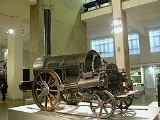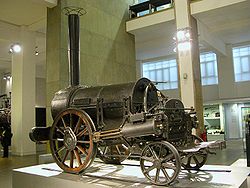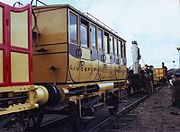
Stephenson's Rocket
Encyclopedia


Steam locomotive
A steam locomotive is a railway locomotive that produces its power through a steam engine. These locomotives are fueled by burning some combustible material, usually coal, wood or oil, to produce steam in a boiler, which drives the steam engine...
of 0-2-2
0-2-2
An 0-2-2, in the Whyte notation for the classification of steam locomotives by wheel arrangement, is one that has two coupled driving wheels followed by two trailing wheels, with no leading wheels...
wheel arrangement
Wheel arrangement
In rail transport, a wheel arrangement is a system of classifying the way in which wheels are distributed beneath a locomotive.. Several notations exist to describe the wheel assemblies of a locomotive by type, position, and connections, with the adopted notations varying by country...
, built in Newcastle Upon Tyne
Newcastle upon Tyne
Newcastle upon Tyne is a city and metropolitan borough of Tyne and Wear, in North East England. Historically a part of Northumberland, it is situated on the north bank of the River Tyne...
at the Forth Street Works of Robert Stephenson and Company
Robert Stephenson and Company
Robert Stephenson and Company was a locomotive manufacturing company founded in 1823. It was the first company set up specifically to build railway engines.- Foundation and early success :...
in 1829.
Design innovations
The Rocket was the most advanced steam engine of its day. It was built for the Rainhill TrialsRainhill Trials
The Rainhill Trials were an important competition in the early days of steam locomotive railways, run in October 1829 in Rainhill, Lancashire for the nearly completed Liverpool and Manchester Railway....
held by the Liverpool & Manchester Railway in 1829 to choose the best and most competent design. It set the standard for a hundred and fifty years of steam locomotive power. Though the Rocket was not the first steam locomotive, its claim to fame is that it was the first to bring together several innovations to produce the most advanced locomotive of its day, and the template for most steam locomotives since. In fact, the standard steam locomotive design is often called the "Stephensonian" locomotive.
Rocket used a multi-tubular boiler, which made for much more efficient and effective heat transfer between the exhaust gases and the water. Previous locomotive boilers consisted of a single pipe surrounded by water. Rocket had 25 copper tubes running the length of the boiler to carry the hot exhaust gases from the firebox. This was a significant development, as it greatly increased the amount of steam produced, and subsequent designs used increased numbers of boiler tubes. Rocket also used a blastpipe
Blastpipe
The blastpipe is part of the exhaust system of a steam locomotive that discharges exhaust steam from the cylinders into the smokebox beneath the chimney in order to increase the draught through the fire.- History :...
, feeding the exhaust steam from the cylinders into the base of the chimney so as to induce a partial vacuum and pull air through the fire. Credit for the invention of the blastpipe is disputed, though Stephenson used it as early as 1814. The blastpipe worked well on the multi-tube boiler of Rocket but on earlier designs with a single pipe through the boiler it created so much suction that it tended to rip the top off the fire and throw burning cinders out of the chimney, vastly increasing the fuel consumption.


George Stephenson
George Stephenson was an English civil engineer and mechanical engineer who built the first public railway line in the world to use steam locomotives...
had designed several locomotives before but none as advanced as Rocket. At the time that Rocket was being designed and built at the Forth Banks Works, he was living in Liverpool overseeing the building of the Liverpool and Manchester Railway
Liverpool and Manchester Railway
The Liverpool and Manchester Railway was the world's first inter-city passenger railway in which all the trains were timetabled and were hauled for most of the distance solely by steam locomotives. The line opened on 15 September 1830 and ran between the cities of Liverpool and Manchester in North...
. His son Robert
Robert Stephenson
Robert Stephenson FRS was an English civil engineer. He was the only son of George Stephenson, the famed locomotive builder and railway engineer; many of the achievements popularly credited to his father were actually the joint efforts of father and son.-Early life :He was born on the 16th of...
had recently returned from a stint working in South America and resumed as managing director of Robert Stephenson and Company
Robert Stephenson and Company
Robert Stephenson and Company was a locomotive manufacturing company founded in 1823. It was the first company set up specifically to build railway engines.- Foundation and early success :...
. He was in daily charge of designing and constructing the new locomotive. Although he was in frequent contact with his father in Liverpool and probably received advice from him, it is difficult not to give the majority of the credit for the design to Robert. A third person who deserves a significant amount of credit is Henry Booth
Henry Booth
Henry Booth was born in Rodney Street, Liverpool, England. A descendant of the Booths of Twemlow, he was a corn merchant, businessman and engineer....
, the treasurer of the Liverpool and Manchester Railway
Liverpool and Manchester Railway
The Liverpool and Manchester Railway was the world's first inter-city passenger railway in which all the trains were timetabled and were hauled for most of the distance solely by steam locomotives. The line opened on 15 September 1830 and ran between the cities of Liverpool and Manchester in North...
. He is believed to have suggested to Robert Stephenson that a multi-tube boiler should be used.
Opening-day accident
The opening ceremony of the L&MR, on 15 September 1830, was a considerable event, drawing luminaries from the government and industry, including the Prime Minister, the Duke of WellingtonArthur Wellesley, 1st Duke of Wellington
Field Marshal Arthur Wellesley, 1st Duke of Wellington, KG, GCB, GCH, PC, FRS , was an Irish-born British soldier and statesman, and one of the leading military and political figures of the 19th century...
. The day started with a procession of eight trains setting out from Liverpool. The parade was led by Northumbrian driven by George Stephenson, and included Phoenix driven by his son Robert, North Star driven by his brother Robert Sr. and Rocket driven by assistant engineer Joseph Locke
Joseph Locke
Joseph Locke was a notable English civil engineer of the 19th century, particularly associated with railway projects...
. The day was marred by the death of William Huskisson
William Huskisson
William Huskisson PC was a British statesman, financier, and Member of Parliament for several constituencies, including Liverpool...
, the Member of Parliament
Member of Parliament
A Member of Parliament is a representative of the voters to a :parliament. In many countries with bicameral parliaments, the term applies specifically to members of the lower house, as upper houses often have a different title, such as senate, and thus also have different titles for its members,...
for Liverpool
Liverpool
Liverpool is a city and metropolitan borough of Merseyside, England, along the eastern side of the Mersey Estuary. It was founded as a borough in 1207 and was granted city status in 1880...
, who was struck and killed by Rocket at Parkside.
Subsequent service
In 1834, the engine was selected for modifications to test a newly-developed rotary steam engine designed by Lord DundonaldThomas Cochrane, 10th Earl of Dundonald
Admiral Thomas Cochrane, 10th Earl of Dundonald, 1st Marquess of Maranhão, GCB, ODM , styled Lord Cochrane between 1778 and 1831, was a senior British naval flag officer and radical politician....
. At a cost of nearly £80, Rockets cylinders and driving rods were removed and two of the engines were installed directly on its driving axle with a feedwater pump in between. On October 22, of that year, an operational trial was held with disappointing results; one witness observing, that "the engine could not be made to draw a train of empty carriages". Due to inherent design flaws and engineering difficulties associated with their design, Dundonald's engines were simply too feeble for the task.
After service on the Liverpool and Manchester Railway, Rocket was used until 1840 on Lord Carlisle's Railway
Brampton Railway
The Brampton railway was a ten mile long track branch railway line on the borders of Cumberland and Northumberland, England, that ran from to on the Alston Line via three intermediate stations, Brampton Junction, and...
around the villages of Tindale
Tindale, Cumbria
Tindale or Tindale Fell is a hamlet in the parich of Farlam in the City of Carlisle district of the English county of Cumbria. .. It is to the south of the A689 Brampton to Alston road. It is a former mining village- both coal and lead were mined here. Limestone was quarried here...
and Kirkhouse, east of Brampton, in Cumberland (now Cumbria
Cumbria
Cumbria , is a non-metropolitan county in North West England. The county and Cumbria County Council, its local authority, came into existence in 1974 after the passage of the Local Government Act 1972. Cumbria's largest settlement and county town is Carlisle. It consists of six districts, and in...
), England.
Preservation
In 1862 Rocket was donated to the Patent Office Museum in London by the Thompsons of Milton Hall, near Brampton.The locomotive still exists, in the Science Museum (London)
Science Museum (London)
The Science Museum is one of the three major museums on Exhibition Road, South Kensington, London in the Royal Borough of Kensington and Chelsea. It is part of the National Museum of Science and Industry. The museum is a major London tourist attraction....
, in much modified form compared to its state at the Rainhill Trials. The cylinder
Cylinder (engine)
A cylinder is the central working part of a reciprocating engine or pump, the space in which a piston travels. Multiple cylinders are commonly arranged side by side in a bank, or engine block, which is typically cast from aluminum or cast iron before receiving precision machine work...
s were altered to the horizontal position, compared to the angled arrangement as new, and the locomotive was given a proper smokebox
Smokebox
A smokebox is one of the major basic parts of a Steam locomotive exhaust system. Smoke and hot gases pass from the firebox through tubes where they pass heat to the surrounding water in the boiler. The smoke then enters the smokebox, and is exhausted to the atmosphere through the chimney .To assist...
. Such are the changes in the engine from 1829 that The Engineer magazine, circa 1884, concluded that "it seems to us indisputable that the Rocket of 1829 and 1830 were totally different engines".
The Replicas
In 1923, Buster KeatonBuster Keaton
Joseph Frank "Buster" Keaton was an American comic actor, filmmaker, producer and writer. He was best known for his silent films, in which his trademark was physical comedy with a consistently stoic, deadpan expression, earning him the nickname "The Great Stone Face".Keaton was recognized as the...
had a functioning replica built for the film, Our Hospitality
Our Hospitality
Our Hospitality is a silent comedy directed, produced, written by and starring Buster Keaton. Released in 1923 by Metro Pictures Corporation, the movie uses slapstick and situational comedy to tell the story of Willie McKay, a city slicker who gets caught in the middle of the infamous Canfield &...
. Two years later, the replica was used again in the Al St. John
Alfred St. John
Al St. John in his persona of Fuzzy Q. Jones basically defined the role and concept of "comical sidekick" to cowboy heroes from 1930 to 1951. St...
film, The Iron Mule
The Iron Mule
The Iron Mule is a 1925 comedy film directed by Fatty Arbuckle.-Cast:* Al St. John* George Davis* Glen Cavender* Doris Deane* Buster Keaton - Indian...
, directed by Keaton's mentor, Roscoe "Fatty" Arbuckle. The subsequent whereabouts of the replica are unknown. There are however at least two other replicas of Rocket in the USA, one built by Robert Stephenson and Hawthorns in 1929 for the Henry Ford Museum in the Metro Detroit suburb of Dearborn, Michigan, the other at the Museum of Science and Industry, Chicago.
The earliest full-size replica of Rocket seems to have been one depicted on a London & North Western Railway postcard (therefore pre-1923).
A cut-away static replica (see photo above) was built in 1935 and displayed for many years next to the original at London's Science Museum, and in 1979 a further, working replica
Replica
A replica is a copy closely resembling the original concerning its shape and appearance. An inverted replica complements the original by filling its gaps. It can be a copy used for historical purposes, such as being placed in a museum. Sometimes the original never existed. For example, Difference...
Rocket was built by Locomotion Enterprises for the 150th anniversary celebrations. It has a shorter chimney
Chimney
A chimney is a structure for venting hot flue gases or smoke from a boiler, stove, furnace or fireplace to the outside atmosphere. Chimneys are typically vertical, or as near as possible to vertical, to ensure that the gases flow smoothly, drawing air into the combustion in what is known as the...
than the original in order to the clear the bridge at Rainhill: the trackbed is deeper than in the 19th century, giving less headroom. Both of these replicas are now based at the National Railway Museum
National Railway Museum
The National Railway Museum is a museum in York forming part of the British National Museum of Science and Industry and telling the story of rail transport in Britain and its impact on society. It has won many awards, including the European Museum of the Year Award in 2001...
, York
York
York is a walled city, situated at the confluence of the Rivers Ouse and Foss in North Yorkshire, England. The city has a rich heritage and has provided the backdrop to major political events throughout much of its two millennia of existence...
.
See also
- Novelty (locomotive)Novelty (locomotive)Novelty was an early steam locomotive built by John Ericsson and John Braithwaite to take part in the Rainhill Trials in 1829.It was an 0-2-2WT locomotive and is now regarded as the very first tank engine. It had a unique design of boiler and a number of other novel design features...
- Invicta (locomotive)Invicta (locomotive)Invicta is an early steam locomotive built by Robert Stephenson and Company in Newcastle-upon-Tyne in 1829. She was the twentieth locomotive built by Stephenson, being built immediately after Rocket.-History:...
- LMR 57 LionLMR 57 LionThe Liverpool and Manchester Railway 57 Lion is an early 0-4-2 steam locomotive. One of a pair designed for hauling freight , built by Todd, Kitson & Laird of Leeds in 1838.-History:...
- John Bull (locomotive)John Bull (locomotive)John Bull is a British-built railroad steam locomotive that operated in the United States. It was operated for the first time on September 15, 1831, and it became the oldest operable steam locomotive in the world when the Smithsonian Institution operated it in 1981...
- Locomotion No 1Locomotion No 1Locomotion No. 1 is an early British steam locomotive. Built by George and Robert Stephenson's company Robert Stephenson and Company in 1825, it hauled the first train on the Stockton and Darlington Railway on 27 September 1825....
- Rainhill TrialsRainhill TrialsThe Rainhill Trials were an important competition in the early days of steam locomotive railways, run in October 1829 in Rainhill, Lancashire for the nearly completed Liverpool and Manchester Railway....
- Sans PareilSans PareilSans Pareil is a steam locomotive built by Timothy Hackworth which took part in the 1829 Rainhill Trials on the Liverpool and Manchester Railway, held to select a builder of locomotives...
External links
- The Science Museum – Stephenson's 'Rocket' locomotive, 1829
- The Engineer magazine examines the differences between the 1829 and 1830 Rocket, as reprinted in Scientific American Supplement, No. 460, October 25, 1884.

